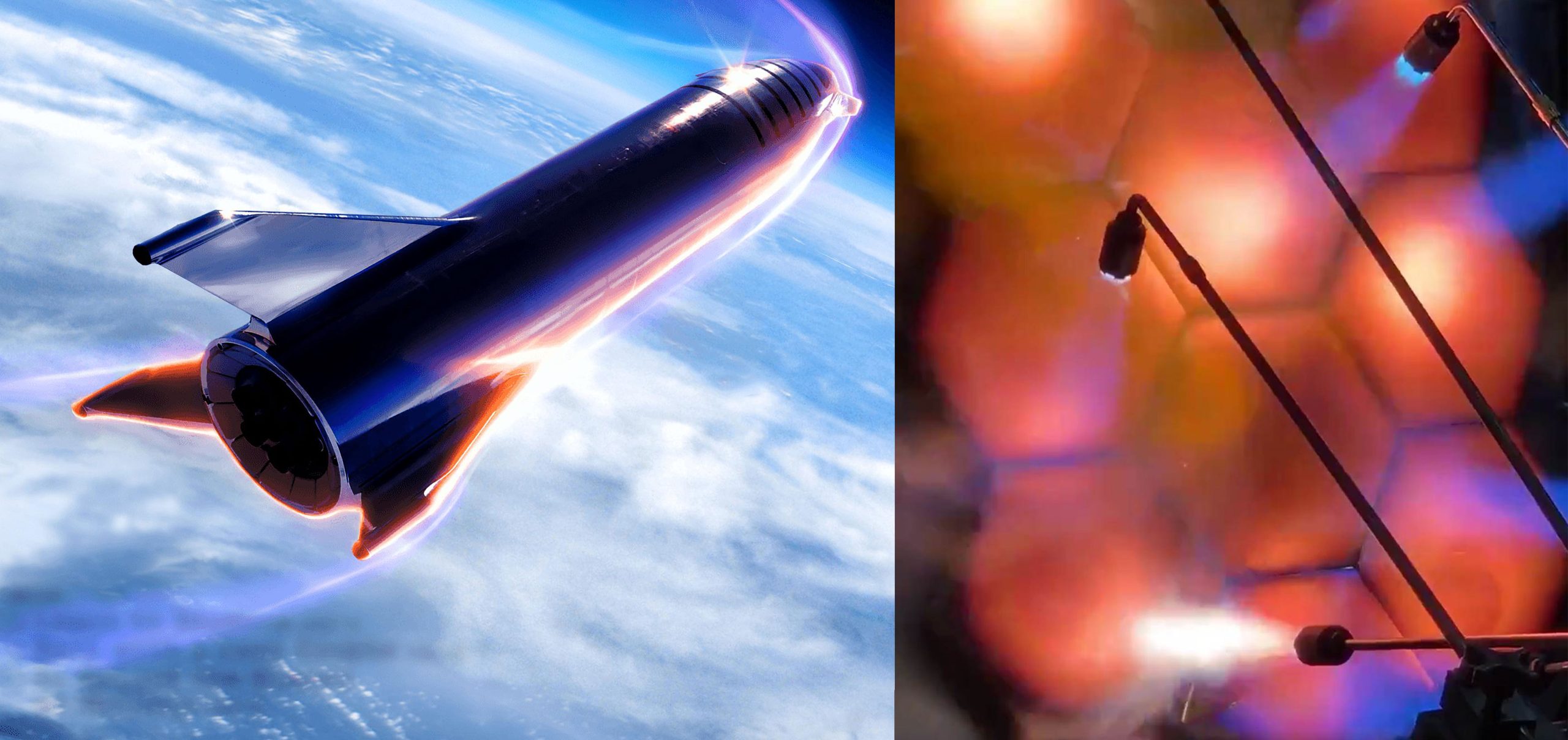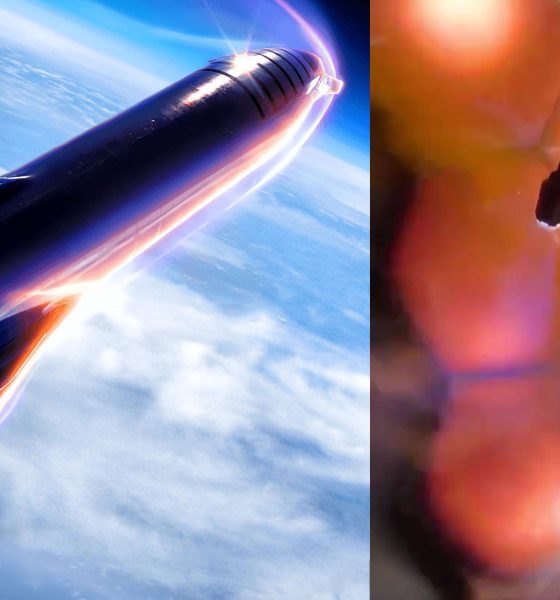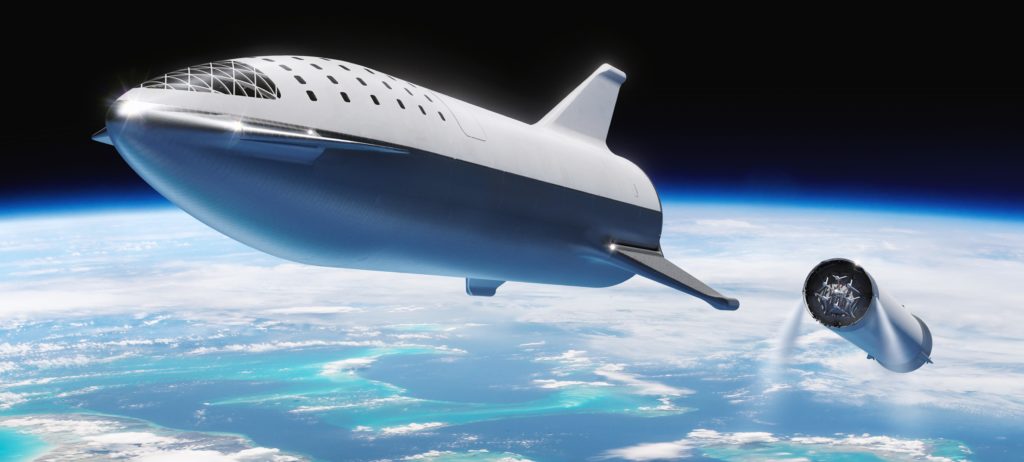

News
SpaceX CEO Elon Musk hints that Starship’s ‘sweating’ metal heat shield is no more
In the latest entry of SpaceX’s ever-changing Starship design process, CEO Elon Musk has indicated that the nominally reusable orbital spacecraft has moved away from a liquid-cooled steel heat shield to something slightly more traditional.
This information came as a SpaceX engineer announced during Cargo Dragon’s CRS-18 webcast that the twice-flown spacecraft would mark the first orbital test of a ceramic heat shield tile meant for use on Starship’s windward side. This major design change comes as a significant surprise and seems likely to either delay Starship’s orbital debut or hinder its ultimate reusability, although Musk just as recently claimed that the spacecraft could reach orbit for the first time less than six months from now.
Testing a possible Starship windward side ceramic tile. Maximizing emissivity is best for conductive/particle heating. Nice thing about steel is that tiles can be very thin, unlike carbon fiber or aluminum airframe.— ln(e) (@elonmusk) July 25, 2019
Thin tiles on windward side of ship & nothing on leeward or anywhere on booster looks like lightest option— ln(e) (@elonmusk) July 25, 2019
Back in late-2018 and early-2019, Musk took to Twitter to announce that SpaceX was pursuing an exotic metallic heat shield that would be cooled in large part by flowing liquid methane through tiny holes on its exterior, effectively ‘sweating’ away energy and preventing steel tiles from melting.
Despite incontrovertible evidence that SpaceX performed some amount of significant testing on the hexagonally-tiled steel heat shield concept, Musk’s July 24th tweets indicate that the liquid-cooled heat shield is unlikely to ever be used on Starship. For unknown reasons, SpaceX is instead pursuing some sort of thin ceramic heat shielding to protect the entirety of Starship’s windward side (i.e. the side facing the atmosphere during reentry). A handful of the first flight-qualified ceramic tiles – shaped for Dragon instead of Starship – will be tested on Cargo Dragon during the spacecraft’s orbital mission and eventual reentry.
Of note, this is not the only major design change Starship has undergone in just the last few months. Speaking on May 30th, Elon Musk stated that the design of Starship’s landing legs/fins and actuating wings and flaps has changed significantly since SpaceX revealed the new tripod fins + canard wings configuration in September 2018. According to Musk, that change will (or at least should) not significantly impact Starship’s schedule.

In fact, per his July 2019 claims that the first full-fidelity Starship prototype(s) could begin test flights in September/October and reach orbit as early as December/January, the Starship/Super Heavy schedule has actually radically sped up in the first half of 2019. In December 2018, Musk stated that he believed Starship had a 60% chance of reaching orbit in 2020, let alone late-2019.
For Starship, the massive spacecraft’s heat shield is arguably its single most important component. A failure to ensure that the heat shield is unprecedentedly reusable and reliable – even in the face of ultra-high-velocity interplanetary reentries – will severely limit Starship’s ability to achieve its ultimate goals of enabling affordable access to space and building a sustainable city on Mars. Musk’s comment that ceramic tiles are just “a possible” Starship heat shield element further indicates that SpaceX has yet to firmly settle on a heat shield design, let alone qualify said shield for orbital flight or kick off the mass-production necessary to completely cover multiple Starship halves.

Admittedly, there is still some good news in this unfortunate development. Most notably, the fact that Starship will still be made of steel means that the non-metallic heat shield tiles can be extremely thin and light, as they can be more or less directly attached to Starship’s steel hull. Additionally, steel Super Heavy boosters may be able to get away with zero heat shielding thanks to the relatively high melting point and heat resistance of certain varieties of stainless steel.
So long as both of those characteristics remain true, it’s likely that it will still make sense for Starship/Super Heavy to be built entirely out of steel instead of something like aluminum or carbon composite. With any luck, Elon Musk will provide a detailed update on the status of SpaceX’s next-generation launch vehicle soon after Starhopper survives its first untethered flight test.
Check out Teslarati’s Marketplace! We offer Tesla accessories, including for the Tesla Cybertruck and Tesla Model 3.

News
Tesla FSD fleet is nearing 7 billion total miles, including 2.5 billion city miles
As can be seen on Tesla’s official FSD webpage, vehicles equipped with the system have now navigated over 6.99 billion miles.

Tesla’s Full Self-Driving (Supervised) fleet is closing in on almost 7 billion total miles driven, as per data posted by the company on its official FSD webpage.
These figures hint at the massive scale of data fueling Tesla’s rapid FSD improvements, which have been quite notable as of late.
FSD mileage milestones
As can be seen on Tesla’s official FSD webpage, vehicles equipped with the system have now navigated over 6.99 billion miles. Tesla owner and avid FSD tester Whole Mars Catalog also shared a screenshot indicating that from the nearly 7 billion miles traveled by the FSD fleet, more than 2.5 billion miles were driven inside cities.
City miles are particularly valuable for complex urban scenarios like unprotected turns, pedestrian interactions, and traffic lights. This is also the difference-maker for FSD, as only complex solutions, such as Waymo’s self-driving taxis, operate similarly on inner-city streets. And even then, incidents such as the San Francisco blackouts have proven challenging for sensor-rich vehicles like Waymos.
Tesla’s data edge
Tesla has a number of advantages in the autonomous vehicle sector, one of which is the size of its fleet and the number of vehicles training FSD on real-world roads. Tesla’s nearly 7 billion FSD miles then allow the company to roll out updates that make its vehicles behave like they are being driven by experienced drivers, even if they are operating on their own.
So notable are Tesla’s improvements to FSD that NVIDIA Director of Robotics Jim Fan, after experiencing FSD v14, noted that the system is the first AI that passes what he described as a “Physical Turing Test.”
“Despite knowing exactly how robot learning works, I still find it magical watching the steering wheel turn by itself. First it feels surreal, next it becomes routine. Then, like the smartphone, taking it away actively hurts. This is how humanity gets rewired and glued to god-like technologies,” Fan wrote in a post on X.
News
Tesla starts showing how FSD will change lives in Europe
Local officials tested the system on narrow country roads and were impressed by FSD’s smooth, human-like driving, with some calling the service a game-changer for everyday life in areas that are far from urban centers.

Tesla has launched Europe’s first public shuttle service using Full Self-Driving (Supervised) in the rural Eifelkreis Bitburg-Prüm region of Germany, demonstrating how the technology can restore independence and mobility for people who struggle with limited transport options.
Local officials tested the system on narrow country roads and were impressed by FSD’s smooth, human-like driving, with some calling the service a game-changer for everyday life in areas that are far from urban centers.
Officials see real impact on rural residents
Arzfeld Mayor Johannes Kuhl and District Administrator Andreas Kruppert personally tested the Tesla shuttle service. This allowed them to see just how well FSD navigated winding lanes and rural roads confidently. Kruppert said, “Autonomous driving sounds like science fiction to many, but we simply see here that it works totally well in rural regions too.” Kuhl, for his part, also noted that FSD “feels like a very experienced driver.”
The pilot complements the area’s “Citizen Bus” program, which provides on-demand rides for elderly residents who can no longer drive themselves. Tesla Europe shared a video of a demonstration of the service, highlighting how FSD gives people their freedom back, even in places where public transport is not as prevalent.
What the Ministry for Economic Affairs and Transport says
Rhineland-Palatinate’s Minister Daniela Schmitt supported the project, praising the collaboration that made this “first of its kind in Europe” possible. As per the ministry, the rural rollout for the service shows FSD’s potential beyond major cities, and it delivers tangible benefits like grocery runs, doctor visits, and social connections for isolated residents.
“Reliable and flexible mobility is especially vital in rural areas. With the launch of a shuttle service using self-driving vehicles (FSD supervised) by Tesla in the Eifelkreis Bitburg-Prüm, an innovative pilot project is now getting underway that complements local community bus services. It is the first project of its kind in Europe.
“The result is a real gain for rural mobility: greater accessibility, more flexibility and tangible benefits for everyday life. A strong signal for innovation, cooperation and future-oriented mobility beyond urban centers,” the ministry wrote in a LinkedIn post.
News
Tesla China quietly posts Robotaxi-related job listing
Tesla China is currently seeking a Low Voltage Electrical Engineer to work on circuit board design for the company’s autonomous vehicles.

Tesla has posted a new job listing in Shanghai explicitly tied to its Robotaxi program, fueling speculation that the company is preparing to launch its dedicated autonomous ride-hailing service in China.
As noted in the listing, Tesla China is currently seeking a Low Voltage Electrical Engineer to work on circuit board design for the company’s autonomous vehicles.
Robotaxi-specific role
The listing, which was shared on social media platform X by industry watcher @tslaming, suggested that Tesla China is looking to fill the role urgently. The job listing itself specifically mentions that the person hired for the role will be working on the Low Voltage Hardware team, which would design the circuit boards that would serve as the nervous system of the Robotaxi.
Key tasks for the role, as indicated in the job listing, include collaboration with PCB layout, firmware, mechanical, program management, and validation teams, among other responsibilities. The role is based in Shanghai.
China Robotaxi launch
China represents a massive potential market for robotaxis, with its dense urban centers and supportive policies in select cities. Tesla has limited permission to roll out FSD in the country, though despite this, its vehicles have been hailed as among the best in the market when it comes to autonomous features. So far, at least, it appears that China supports Tesla’s FSD and Robotaxi rollout.
This was hinted at in November, when Tesla brought the Cybercab to the 8th China International Import Expo (CIIE) in Shanghai, marking the first time that the autonomous two-seater was brought to the Asia-Pacific region. The vehicle, despite not having a release date in China, received a significant amount of interest among the event’s attendees.








